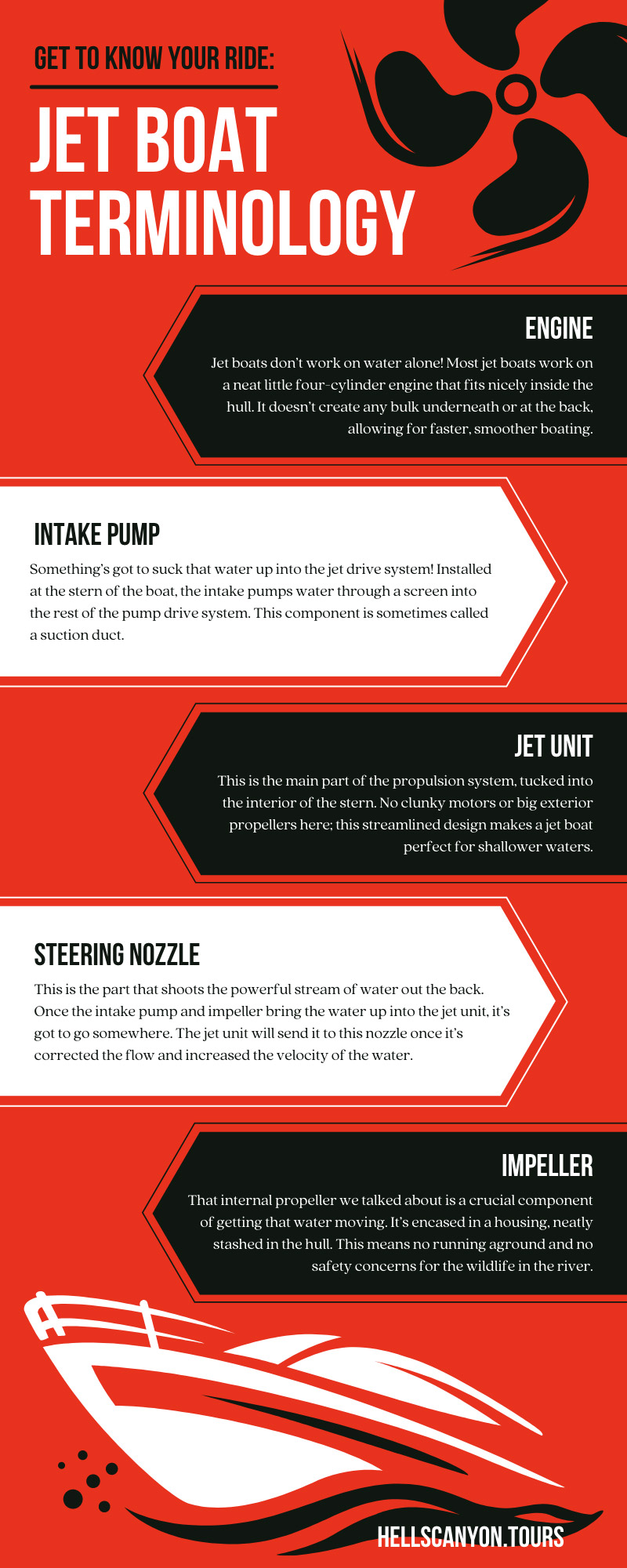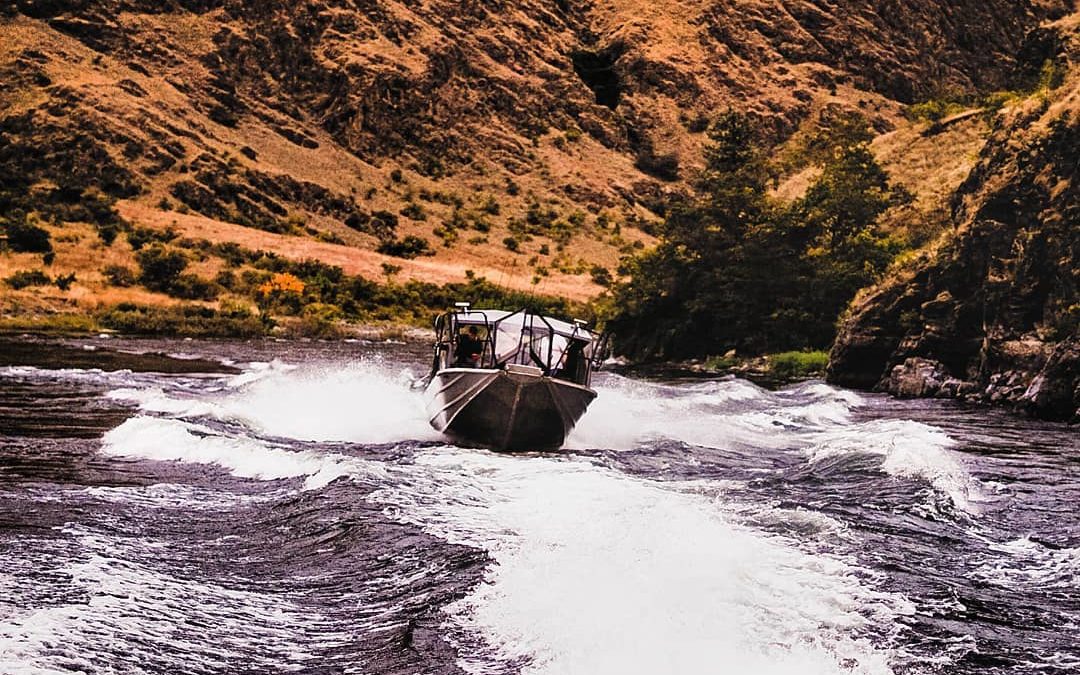What is a jet boat, exactly? How is it different from your garden-variety pontoon or fishing boat? River Adventures is proud to show our visitors the majesty of Hells Canyon from a state-of-the-art jet boat. Our Hells Canyon tour boat is 36 feet long and completely custom-built! But whether you’re jetting around the Snake River with us or trying out jet boating on your own, it’s useful to know the anatomy of the boat. Here’s a rundown of some basic jet boat terminology—get to know your ride!
How Does It Work?
Jet boats work on Newton’s Third Law of Motion: “For each action, there is an equal and opposite reaction.” Push a stream of water out the back of your boat, and it’ll move forward.
These boats are different from your typical motorboat. Instead of an external propeller like the boats you may be used to, a jet boat gets its propulsion from a strong, fast flow of water. The jet boat’s propeller is contained inside a housing in the hull and is actually called an impeller!
The intake pump sucks water into the impeller, then an external nozzle pushes it out the back, moving the boat forward. Because the impeller is more discreet than the external propeller of a motorboat, you can use a jet boat in shallower waters. That impeller won’t get stuck or stumped.
Engine
Jet boats don’t work on water alone! Most jet boats work on a neat little four-cylinder engine that fits nicely inside the hull. It doesn’t create any bulk underneath or at the back, allowing for faster, smoother boating.
The engine, comprised of specially designed motors, drives the pumps to start working their magic, starting with the intake. River Adventures boasts a majestic tour boat with three jet driving engines instead of a mere one or two. After all, we need a little extra power when our jet boat is 36 feet long! (Most jet boats max out between 18 and 24 feet, but here, we go big or go home.)
Intake Pump
Something’s got to suck that water up into the jet drive system! Installed at the stern of the boat, the intake pumps water through a screen into the rest of the pump drive system. This component is sometimes called a suction duct.
The more forcefully the intake pump pulls that water up, the faster your boat will go. Once the intake has gathered that moving water and pushed it through, the water moves into the jet unit.
Impeller
That internal propeller we talked about is a crucial component of getting that water moving. It’s encased in a housing, neatly stashed in the hull. This means no running aground and no safety concerns for the wildlife in the river. (Should you take your own jet boat for a spin on the lake at home, any swimmers in the area will also thank you.)
The impeller is crucial to getting the water flowing into the jet unit. After all, these boats are powered by the force of that water!
Jet Unit
This is the main part of the propulsion system, tucked into the interior of the stern. No clunky motors or big exterior propellers here; this streamlined design makes a jet boat perfect for shallower waters.
The interior jet unit corrects flow rotation (water spinning round and round) from the impeller. This action creates a steadier, smoother stream of water. The jet unit will also increase the velocity of the jet stream, so when it shoots out the back, your boat will zoom quickly to your destination!
Steering Nozzle
This is the part that shoots the powerful stream of water out the back. Once the intake pump and impeller bring the water up into the jet unit, it’s got to go somewhere. The jet unit (see above) will send it to this nozzle once it’s corrected the flow and increased the velocity of the water.
It’s called a steering nozzle because that’s what it does for your jet boat! When you’re on your Snake River jet boat tour with River Adventures and the boat turns from side to side, that’s the steering nozzle at work. When the skipper points the jet stream one way, that force pushes the stern in the opposite direction, and the boat turns.
Astern Deflector
Jet boats can be tricky to maneuver around docks. They’re most famous for their incredible speed. However, there are extra features that help make the process easy.
In order to steer a jet boat in reverse or make it stand still, the astern deflector, or diverter, is lowered over the jet stream. This action changes the direction of the powerful stream as it leaves the jet unit.
Planing Hull
Part of why jet boats work so well in shallow waters is because there’s very little fuss in the hull of the boat. There aren’t a bunch of clunky bits sticking out, and the boat sits prettily on top of the water. Part of the jet propulsion system sits above the waterline so that water can shoot out the steering nozzle more easily.
The weight on jet boats is largely supported by hydrodynamic lift (held up by movement) rather than hydrostatic lift (held up by buoyancy). This support is called planing, and it lets the jet boat zoom across the top of the water. Only the rear portion of the hull, where the propulsion system sits, displaces any water.
Next time you visit Hells Canyon, book a guided jet boat tour down the Snake River, courtesy of River Adventures. If you’re an avid boating enthusiast, our tour boat will be of particular interest to you, with its completely custom build and extra engines for supreme jet power. Even if you’re just an outdoorsy type looking for a fun adventure on the water, get to know your ride with this jet boat terminology. You learn something new every day—and once you’re on our jet boat tour, our experienced guides will give you even more insider knowledge and top tips for enjoying your stay in Hells Canyon.


Recent Comments